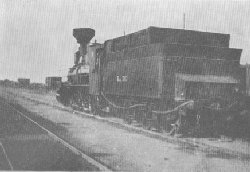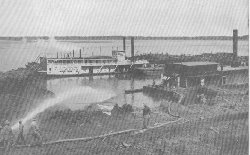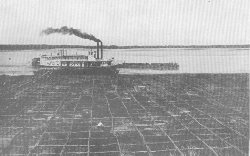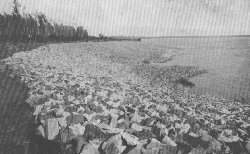|
An American syndicate has offered to complete the building of the Siberian Transcontinental Railway, from its present terminus at Vladivostok in southeastern Siberia to Cape Numiano, on Bering Strait. Russia has already built 5,542 miles of the Siberian Railway, at a cost of $400,000,000. This has, of course, been a drain on the treasury, and on the physical resources of that frigid country, since the services of 70,000 men have been required for a period of nearly ten years.
This great, ambitious, Alexandrian scheme would encircle the earth with a double band of steel and the construction and operation of a railway system 20,000 miles in extent, traversing three continents, with one terminus at Calais on the channel coast of France and the other at New York city. On the Russian side the czar's engineers have made an accurate survey of the ground, and they have found no such obstacles along the route as those which have already been overcome in building to the present terminus; for instance, that at Lake Baikal. This is a great inland fresh water lake, 1,560 feet above sea level, in a clef of the Baikal Mountains. It ranges in depth from 800 to 5,000 feet and occupies an area of 12,000 square miles, with a minimum width of thirty miles.
But the incapacity of so cumbersome an arrangement soon became manifest, and the great thickness of the ice even further limited its usefulness, so that it was decided to build around the south, and this is now being done. Bering Strait, between Capes Numiano, Siberia, and Prince of Wales, Alaska, is a fraction more than nineteen miles wide—a lesser distance than from Dover to Calais—only one-fourth the width of the Yukon River, 1,200 miles above its mouth. The American project involves a tunnel for Bering Sea, which will not be nearly so difficult a matter as it would appear at first glance. To begin with, the Diomede Islands would break the continuity of a tunnel twice, so that no section of it need be more than six or seven miles long. The czar spent $400,000,000 building 5,542 miles. The new road, to make connections at both ends, will be just about that length—perhaps 1,000 miles less. One inducement on the part of the czar to accept the syndicate's offer is the fact that there is no more fertile land anywhere than southeastern Siberia, and its millions of square miles of grazing and farming and fruit lands would support almost the world, if they were employed. They have been opened and worked just sufficiently to demonstrate their value. The mines of the farther north and in the mountains are among the richest on earth in gold, copper, coal, platinum, silver, salt, iron, lead, zinc and tin.
The waters of Bering Sea and the Arctic and of the internal fresh water lakes and rivers will furnish enough fish to feed the world if need be, and the waters being extremely cold, the northern fish are noted for the delicacy of their flavor and the firmness of their meat. There is that other phase of the proposition, however, that must appeal to all namely, the saving in time in traversing the earth or any portion of it. Within ten years one may girdle the earth within twenty days.
Several varieties of dredges are used; one, the dipper dredge, which scoops out the mud as a man would with his curved hand; another, the clam-shell dredge, which goes down like an open clam-shell and comes out with it closed and the load inside; and third, the new hydraulic dredge, which thrusts its snout down into the mud, sucks it up and vomits it forth through a long tube into a barge or upon the shore. The old-fashioned bucket-ladder-dredge has been used very little of late years. The dipper dredge is comparatively a simple affair. It consists of a huge iron scoop at the end of a long arm and hung to a heavy derrick at the end of a barge. The arm is driven by a powerful engine and descends almost perpendicularly into the stream to be dredged. It is scraped along the bottom by means of a chain attached to the end of the arm, and when it is filled and is pulled to the surface the bottom of the scoop is opened by pulling a rope and loosening a pin. Then the load slides out. The clam-shell dredge is made of two separate scoops hinged together at the upper part. The arm of the dredge is shot down into the mud and the scoop sinks into it. As soon as the derrick raises the arm the jaws of the dredge come together. When the load has been brought up, a simple device releases the jaws and the load falls out. Where streams are loaded with mud, or where canals are being dug in very soft mud, the hydraulic dredge cannot be improved upon as a digger. This dredge is equipped with a suction pump, a powerful engine, a long, hollow arm which reaches down into the mud, and a cutter at the end of the arm supplied with steel knives which burrow into the soil and loosen the mud so that it can be drawn up easily by the suction pump. The operation of this dredge is simple. When the barge is in position a big post is shoved down into the mud and the barge is anchored to it. Then the spout is shoved down into the mud, the engines started and the cuter and pumps loosen and bring up the mud. When the mud has been brought to the surface it is often run directly into a mud scow, but sometimes it is carried through piping 1,000 feet or more, and dumped on shore. When one spot in a river has been scooped clean, the anchoring post, or "spud," is drawn up and another post is set out behind by machinery, to force the barge along. So great is the capacity of these dredges for cutting and drawing up mud, that one of them pumped up more than 165,000 cubic yards of mud in twenty days. XXXX |



